#The actual viking age ended but people were obviously still living in Scandinavia & it was a very long and messy transition
Explore tagged Tumblr posts
Text
The earlier HTTYD books occasionally refer to Hiccup as 'the last great viking hero' which is already a bit melancholy but grows even more so with the context of the later books. I doubt viking society as it was known and understood just totally imploded into dust during Hiccup's lifetime, it's even implied in his old man monologues that that doesn't happen. But it does imply that the end of the viking age, the death of the viking world and way of life is rapidly approaching. Just as the dragon time is over, and the dragons are slowly, slowly leaving as Hiccup grows up and old, the Viking time ends and they too slowy, slowly, die out. I wonder if Hiccup saw this coming decline and thought it was because the vikings couldn't live without dragons, economically and spiritually. How awful, to lose the thing you fought to save and sent away and then your culture year after year.
#httyd books#httyd book spoilers#realistically 'culture death' is a lot more complicated outside of 'and then something happened and everyone here died oops'#The actual viking age ended but people were obviously still living in Scandinavia & it was a very long and messy transition#The 'viking age' was more of a thing historians imposed onto history rather than a clear cut rise of x culture abrupt end of x culture#But#The HTTYD vikings have been DEPENDING on dragons for centuries#it's a huge part of their culture their farming their very survival#Slavery human and dragon was lowkey the backbone of a huge portion of viking society.#idk if Hiccup and a centralised government/sovereign could have pulled them out of the tailspin loosing dragons would eventually put them i#Economics aside the loss of dragons after a couple of generations would start affecting culture aesthetics etc which might have led#to a new culture divorced from a lot of OG HTTYD viking society#either way I don't think the vikings as a culture and society survive the loss of dragons#shut up flynn
27 notes
·
View notes
Text
Nightbringer24′s (personal) guidlines on using arms and armour when writing Medieval/Fantasy fiction. Part 1: Weapons.
Before I begin, I want to make this clear: these are my own guidelines that I adhere to and what I personally like to see in fiction. They are by no means the be-all and end-all of writing fantasy fiction.
Fantasy is doing whatever the hell you want, and I by no means want to come across as saying that you can’t do this or that. But if I manage to inspire people in some form or another, I’m happy.
So let’s begin.
First off, we’re starting this whole thing with the fact that virtually every Western created fantasy story is basically Europe in some form or reflection of sorts. Now, while this can be seen as stagnating the fantasy genre, I do feel that this is a very narrow minded view of how diverse Medieval Europe actually was. One should not consider that every country was basically Medieval England/France, and fantasy should reflect this. Conversely, one should not consider that every fighter in the army of a king/prince/lord/duke/queen/princess/etc was a fully armoured knight on a tall horse armed with a lance, sword and shield (which is in itself an anachronistic combination in of itself, but I’ll touch on that later). Yes, there were many forms of arms and armour that were common throughout Europe, but that was simply because of one simple factor: they bloody worked. That’s it.
One should also consider one simple fact: no nation in Europe during the Middle Ages existed in a vacuum. Even if they didn’t fight against or with each other, they did certainly trade with each other, meaning that certain styles of armour from the European continent would certainly be found in places like Britain or Scandinavia, while even soldiers from the British Isles would be found fighting in armies as mercenaries in Germany or Italy (as did actually happen). The Middle Ages was the times when the biggest race was the arms race; as armour became stronger and more effective at covering a knight’s person, so too did the weapons have to become more effective at penetrating the armour in return.
Now, obviously, this little guideline does kind of run counter to the whole point of fantasy. While this obviously can be a good thing for the creator and the fans, for those of us who are inclined for a little bit of consistency in what they read, it can be very frustrating. Like, how is it that a civilization that can create full-plate armour and well-forged steel swords does not care one jot about armoured barding for their horses? No sense!
Anyway, let’s begin. For the purposes of generalization and ease, we’ll go with the assumption that all Medieval/Fantasy worlds are using the Late Middle Ages (14th century onwards) as their base.
We’ll start off with the basic thing: the weapons. Everyone needs weapons, but every weapon has a certain job that it can accomplish and some that it can’t. For example, a sword and an axe are just as good at killing an unarmoured or lightly armoured opponent, but the axe is also useful for other day-to-day activities while the sword is solely a fighting weapon.
So let’s start from the basic stuff and work our way up.
Daggers/Knives: this needs no improvement or great explanation on. Nearly everyone in the Medieval world had a dagger, from the lowliest serf to the greatest king. They were a tool of great utility and a great backup weapon as well. Knights were just as prone to carrying around daggers as were assassins. Although obviously certain limits are presented with these weapons: a peasant isn’t going to be carrying around a master-crafted dagger with intricate lion’s head adornments. If anything, it’ll be a simple cutting tool that was used for whittling wood or skinning an animal. However, one type of knife that would have seen much use in combat was the Rondel dagger.

This type of knife is the perfect example of what I mean about Europe in the Middle Ages being in an arms race. The Rondel dagger, while perfectly able to kill an unarmoured opponent with ease, one of its best uses was to kill an armoured knight, slipping through the joints under the armpit in to the rib-cage or through the visor of a helmet. English and Welsh longbowmen during the Hundred Years Wars were known to carry similar daggers and these would have also been the main backup weapon of the English and French knights and man-at-arms during the Wars.
Axes: An axe is an axe. There’s not a massive amount to elaborate on with the axe, but the point does need to be made that for the standard peasant levy, an axe would have been their go-to weapon. Everyone needs cut wood for a fire, so it’s not unreasonable to see peasants or lower-class fighters carrying around an axe. For civilizations that live in heavily wooded areas or groups that carry out raids for a living, like the vikings, the axe would have been their go-to weapon. Conversely, during the Mid to Late Middle Ages, the use of the axe by mounted knights did see a revival, since the force and power that could be carried through the swing of an axe could easily down an armoured opponent. Robert the Bruce of Scotland killed an English knight before the battle of Bannockburn by hitting him with such force that he broke the shaft of his axe (or so the story goes). There was another type of axe that was used almost exclusively by knights and man-at-arms, but I’ll touch on that later.
HOWEVER, I would like to make one thing clear: double-headed axes did not exist as combat weapons in large scales. They were large and very heavy, meaning that whoever used them was going to be a very tall and very strong individual. A good examples of an axe to give would be the simple two-handed axe, like the Sparth axe used by the Scots-Irish mercenaries known as the Gallowglass.
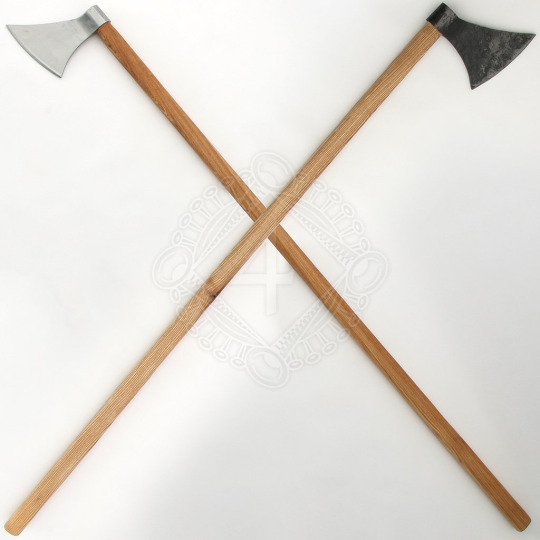
War hammers: War hammers are really another peasant weapon that when pressed in to combat prove to be a devastating weapon. While war hammers are traditionally single headed metal weapons with a spike on the rear, large two-handed variants called mauls existed, both of which saw use by knights and lower-ranking soldiers alike. In a quick pinch, stone mason hammers would easily be used to cave in plate armour.
Swords: Everyone knows a sword. Everyone knows what one looks like and how it is used (the accuracy of how will depend on how much you like watching fencing videos on YouTube). However, this does lead to a problem in that nearly every creator of fantasy decides to give every person in their world, regardless of station, a knightly longsword. You know the type I mean. You get the image of it in your head when you hear or read the word ‘knight’. That wouldn’t have happened. Even as smithing improved and plate armour became prevalent, the sword was still a status symbol of the nobility since it was an expensive weapon to produce and to equip and took a long time to master.
HOWEVER, this does not mean that a non-knight character couldn’t have a sword and there are some types of sword designs that could easily be used by a non-noble character.
First up, we have the falchion.

This was single edged, heavy sword that could be used single handedly alongside a shield or by two hands. Now this was not an elegant weapon, as the design shows. This blade was purely designed for hacking and slashing your opponent to death. There is some dispute on whether this was a weapon that was used solely by the peasantry (since it would have been able to serve many peace-time jobs) or by knights as well. Personally, I consider this the go-to weapon for a mercenary character.
Next is the arming sword.

This sometimes called the Knightly Sword, since it was used right from the 10th century to the 15th century. This more the type of the sword that would be used in the sword and shield combination, since it was single-handed sword with a heavy-blade offset by a weighted pommel. However, with the creation of the two-handed longsword and the hand-and-a-half ‘bastard sword’ in the Late Middle ages, this sword became a backup weapon for knights and men-at-arms. These sort of swords evolved from Viking/Norman swords which had a small and more rectangular crossguard. This type of sword would work for characters that are in a city militia or are employed by a fairly wealthy noblemen as guards. Conversely, if it’s an older pattern sword, you could easily have it as a family heirloom. Or have a family of looters. Either one works.
Then there’s the great swords. Now, technically, there weren’t any swords that were historically called ‘great swords’, that’s a more modern pop culture invention. Claymores and zweihanders did exist as they were named, but they wouldn’t be called great swords either. But, they did have their uses. In combat, they wouldn’t have made great fencing swords; they were large, heavy and very unweildly. Their best use was in the mass attack, with armoured knights/man-at-arms charging in to massed enemy ranks of infantry and smashing in to them in a bloody melee. Another example is the more historical use of the zweihander which was their use to break enemy pike formations during the Italian Wars by the doppelsoldners of the Landsknecht mercenary regiments.
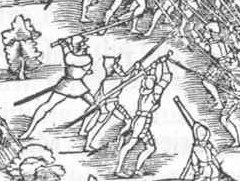
They could have been used to kill horses, but that would have probably been a rare occurrence and should probably only be used when the main protagonist is going up against a secondary or tertiary villain.
Also, one point needs to be made about the sword: in the right hands, every part of the sword was lethal. The pommel made a good bludgeon while effective use of the crossguard could disarm an opponent and also could be used to kill an opponent by gripping the blade and driving the crossguard in to the opponent’s face or head in the mordstreich or murder-stroke.
Spears: It’s a long staff of wood with a sharp metal point on the tip. However, that is not to say that a knight/man-at-arms wouldn’t be caught using a spear. It was a good offensive and defensive weapon, on horse or on foot. Since a spear could range from a simple wooden staff with a sharpened point to a staff with a metal tip, it could be used by a whole breadth of characters from peasant militia given weapons to professional men-at-arms.
Lance: Like the sword, this is also the main weapon that people envision when they hear or read the word ‘knight’. Basically, a length of wood at a midway length between the spear and the pike, it would be held underarm (or couched) by knights or other cavalry and would be used at the charge at full tilt. After the charge hit home, it would then be discarded and replaced with either a sword or a mace, since it was far too ungainly to be used in a close melee. Some lances, like those of the Polish Winged Hussars were constructed to be hollow, which meant they could be longer and could help in defeating formations in pike and spearmen.
Pikes: This is an even longer staff of wood with a sharp metal point on the tip. Usually between 3 and 7.5 metres at the extreme end (10 to 20 feet) in length, they were large and ungainly weapons primarily used as defensive weapons to guard against cavalry charges, although well trained fighters could use them as an offensive weapon. The main groups to use them in large numbers during the medieval period was the Lowland Scots and the Flemish, both of whom who lived in largely open geographical areas. Mercenaries are generally the best people to have pikes in a story.
Javelins: These were not used in great numbers past the Saxon conquest of England except in Ireland by light infantry known as kerns, but in a fantasy world, it wouldn’t be too obscure to have javelin armed troops in your armies, especially if they come from an area of low wealth.
Darts: This is kind of a midway point between an arrow and a javelin. It has a shorter reach than the javelin but is more accurate because of fletchings on the rear of the staff, making its flight more stable. Again, these would work more for soldiers from low wealthy areas.
Halberds: A mix of the spear and the axe, this was a brutal and brilliant all rounder weapon. Used predominantly by infantry by the later stages of the Middle Ages, it was an effective tool against cavalry, being able to spear horse, trip them with their blades or hook down their riders. Against infantry, it had all the uses of the spear and the axe in one tool that could easily be mastered.
Polearms: Now, this is a tricky one. The definition of a polearms as used by Wikipedia is: “...a close combat weapon in which the main fighting part of the weapon is fitted to the end of a long shaft, typically of wood, thereby extending the user's effective range. Spears, glaives, poleaxes, halberds, and naginata are all varieties of polearms.” However, since I’ve already covered spears and halberds above, I’ll go over the over ones now.
First is the glaive.
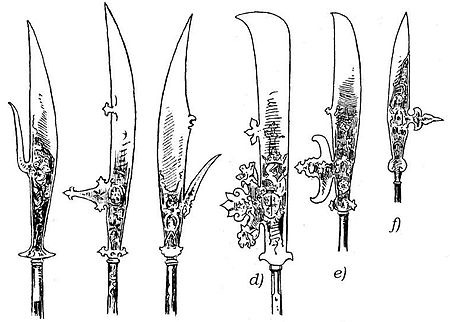
This is a single edged blade fitted on to a staff, primarily used as a cutting and thrusting weapon. There are historical artistic examples of glaives where the blade is longer than the staff it’s fitted to, so there’s a variety to create with them.
Next is the bill.
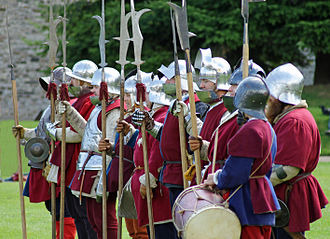
This the poor-mans halberd, but that doesn’t make it any less lethal. Used in significant numbers by the English forces from the Hundred Years War up to the reign of Elizabeth I, it was a wood cutters billhook attached to a 5 to 6 foot long staff. As the centuries progressed, it took on more forms as elements were added to the billhook to turn it from a hacking weapon in a more halberd-esque weapon.
Then there’s the volgue.

Similar to the glaive and bill, it was a simple blade with a spike attached to a long piece of wood by binding it to the wood. The design and shape of the blade made it more of a hacking weapon than a cutting one, but it did its job well.
Then there’s the bardice.
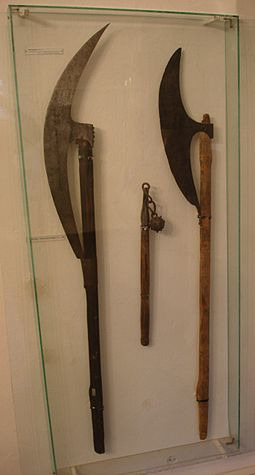
This is basically an axe on steroids.
There are more examples, but if I added them, then this piece would run incredibly long.
All sorts of polearms are generally used by lower class soldiers, usually yeomen or levied soldiers.
Poleaxes: While this weapon would fall under the definition of ‘polearm’, I feel that the weapon deserves a mention of its own.

From the 14th century onwards, this weapon largely replaced the sword as the weapon of choice of armoured knights and men-at-arms because of one simple reason: it gave literally no fucks about armour. As shown on the example above, it was double headed, with one side having an axe-head while the other having a hammer head. Some examples replaced the axe or the hammer with a spike, but either example works. Mounted to a long piece of wood, usually 6 feet in length, it would be swung with two hands and could decimate unarmoured and lightly armoured infantry and would easily batter down armoured infantry and cavalry. During the Wars of the Roses, this was one the main weapons used by armoured infantry on both sides of the conflict, with many graves from the infamous Battle of Towton being shown to have many injuries inflicted by this weapon. If you don’t want to give a knight a sword, then I really suggest you give them a poleaxe.
Maces: We all know what a mace is. With either a metal or wooden shaft, a large metal head was attached to the head, transforming a simple club in to a brutal killing machine. Sometimes, the metal head would be given ridges, called flanges, which would help it in denting or breaking armour. A weapon generally favoured by knights/men-at-arms as a shock weapon, there were longer shafted variants that were exclusively used by mounted knights/men-at-arms. A spiked version of a mace is called a ‘morning star’, which is not a weapon that has the head attached to the shaft by a chain. That’s a flail which I will cover below.
Flails: Now, the name of this does get some people confused (I know it confused me when I was younger) between the flail and the morning star. In fact, the flail came in two variations: the peasant flail and the ball-and-chain flail.
First, the peasant flail.

Like the bill and the axe, this was originally a farming tool that was easily turned to warfare. Consisting of a long wooden shaft with a smaller wooden head attached by a short chain to the longer shaft. Some examples were studded while others were simply reinforced with metal bands. It was effective, as it was used with great effective by Hussite peasant forces against Catholic crusaders during the Hussite wars. It could easily bash aside a shield and unhorse a mounted opponent, but it lacked precision and was next to useless in a close-quarters melee. A good weapon to arm a peasant with.
Next we have the ball-and-chain flail.
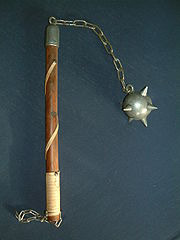
This is another weapon that suffers from bit of the pop culture disease. From sources gathered, they weren’t a very common weapon but most likely came West from the Kingdoms of Rus. But even if they were used, they would require a HUGE amount of skill and strength to use correctly because it a swing is missed, the user runs the risk of injuring their hand or their own body when the ball comes back towards them from momentum.
Bows: Now we’ve covered the close-up weapons, let’s go on to the longrange weapons. Everyone knows the bow. It is, along with the sword, the quintessential weapon of the Medieval world and is also the quintessential weapon of the fantasy world too. But, like swords, they come in many flavours and styles and are often altered by pop culture.
So let’s begin with the most basic and most well-known bow: the longbow.
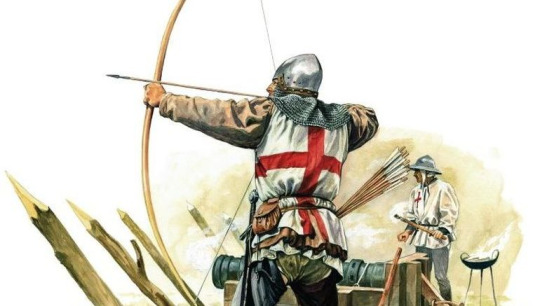
Constructed from a bendy but strong type of wood, mainly yew heartwood, in a single piece (or self bow), it forms a recognizable D-shape when strung. Estimates of the draw weight vary but it’s generally accepted that the bow could achieve up to 100 lbs in draw weight, which is pretty hefty. However, this came with a trade off in that the user would have had to have begun training in the use of the bow from a very young age. Also, there is the myth about the amour penetration ability of the longbow. While it could have been able to penetrate softer armour (chainmail, padded jackets, leather, etc) with a bodkin point with relative ease, a fully armoured knight would have very much been able to shrug off a hit from a longbow loosed arrow with ease. So, if you’re writing a scene with longbows, bare that in mind (unless it’s a magic bow or magic arrows, then just go nuts).
Like the axe, the spear, the bill, the hammer and the flail, the longbow would have seen much use by peasants as, during the Middle Ages, the English monarchy made sure that all subjects were trained to use the longbow every Sunday, so it saw much use during the Peasants’ Revolt of 1381.
Next are shortbows. Now these could either be smaller versions of the D-shaped longbow or the more intricate recurve bow. Again, like the longbow, these bows could easily have a draw weight in excess of 100 lbs, but also had the advantage of being able to be used on horseback by light cavalry. However, they did lack the same ability to punch through plate armour as the longbow did.
If you want bows that can penetrate plate armour though, then look no further than:
Crossbows: While the longbow had the range and rate of fire, the crossbow had the power, being able to penetrate plate armour. While it was easy to train people with in comparison to a longbow (a matter of weeks for the crossbow vs half a lifetime for the longbow), it wasn’t without its drawbacks. In inclement weather, the longbow could easily be destrung and kept dry while destringing the crossbow was a long and laborious task, meaning that many times the archers didn’t bother, which would lead to disastrous consequences (like at the battle of Crecy). There was also the fact that in the space of a minute, a well-trained longbowmen could easily loose off 10 to 12 arrows while a well-trained crossbowmen could at best manage half that. Again, like with the shortbow, smaller crossbows could be used on horseback but required massive amounts of skill to get it right when fighting on the move.
There is also another variant of the crossbow that was used in Europe, the arbalest.

Instead of the older style of crossbow which required the used to manually pull back the string to the trigger latch, which saw massive amounts of energy needed, the arbalest was fitted with a windlass which made drawing the string back easier. A well trained crossbowman, with a good vantage point, plenty of time and plenty of bolts, could wreak havoc on an enemy force.
Now, I’ve covered all the basic weapons, but I’m going to touch on one more aspect of medieval weaponry that is largely ignored and is something that I feel can really set apart your fantasy world from others if you decide to include it.
Black powder.
Now gunpowder weapons were used by European armies during the Medieval ages and, while they were very basic, they still caused massive amounts of damage to the enemy. Your gunpowder weapons came in three forms: bombards, handgonnes and ribaulds.
A bombard was your basic large bore cannon.
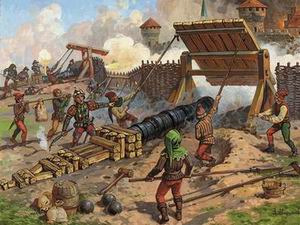
A long iron tube, it was mainly used in sieges where it would be placed in to a presighted position, then fired large stone balls at enemy castles and walls. It’s size made it slow to load and once it was set it was probably never going to move again for the duration of the battle. A perfect target for light infantry and cavalry.
Next is the handgonne.

Similar in design to a bombard (an iron tube with a vent hole for ignition), this one was smaller, being able to be carried by a man. Combine with a large stick as a stock for the back to make it easier to use, sometimes it was used by one or two men. Like the bombard, it would have been cumbersome to load and fire, especially in a pitched battle, but that doesn’t mean it wouldn’t have been devastating to use.
And lastly, we have a very strange but no less destructive weapon, the ribauld, or as it was sometimes called, the organ gun.

As the name suggests, it had several barrels arrayed in a single line (although some sources say they were spread like a duck’s foot) like an organ which would all be fired simultaneously in a devastating burst of smoke, fire and lead. Compared to the bombard, they were designed to be more maneuverable but would still have been cumbersome to use, so would most likely have seen use when the army using them was in an entrenched or prepared position. Like the handgonnes and bombards, the ribaulds would only be crewed by men that the commander of the army knew could use them.
And there we have it. A list of the various weapons and arms that you could use to arm members of the populace of a Medieval/Fantasy world and have them kill other members of the populace with. Again, I’m not saying that anyone who reads this must adhere to it, but it’s just a guideline of what someone who enjoys fantasy and history would like to see.
#world building#writing#reference#writing reference#medieval fantasy#fantasy#weaponry#swords#axes#spears#bows#lances
136 notes
·
View notes
Text
#httyd books#httyd book spoilers#realistically 'culture death' is a lot more complicated outside of 'and then something happened and everyone here died oops'#The actual viking age ended but people were obviously still living in Scandinavia & it was a very long and messy transition#The 'viking age' was more of a thing historians imposed onto history rather than a clear cut rise of x culture abrupt end of x culture#But#The HTTYD vikings have been DEPENDING on dragons for centuries#it's a huge part of their culture their farming their very survival#Slavery human and dragon was lowkey the backbone of a huge portion of viking society.#idk if Hiccup and a centralised government/sovereign could have pulled them out of the tailspin loosing dragons would eventually put them i#Economics aside the loss of dragons after a couple of generations would start affecting culture aesthetics etc which might have led#to a new culture divorced from a lot of OG HTTYD viking society#either way I don't think the vikings as a culture and society survive the loss of dragons
The earlier HTTYD books occasionally refer to Hiccup as 'the last great viking hero' which is already a bit melancholy but grows even more so with the context of the later books. I doubt viking society as it was known and understood just totally imploded into dust during Hiccup's lifetime, it's even implied in his old man monologues that that doesn't happen. But it does imply that the end of the viking age, the death of the viking world and way of life is rapidly approaching. Just as the dragon time is over, and the dragons are slowly, slowly leaving as Hiccup grows up and old, the Viking time ends and they too slowy, slowly, die out. I wonder if Hiccup saw this coming decline and thought it was because the vikings couldn't live without dragons, economically and spiritually. How awful, to lose the thing you fought to save and sent away and then your culture year after year.
27 notes
·
View notes